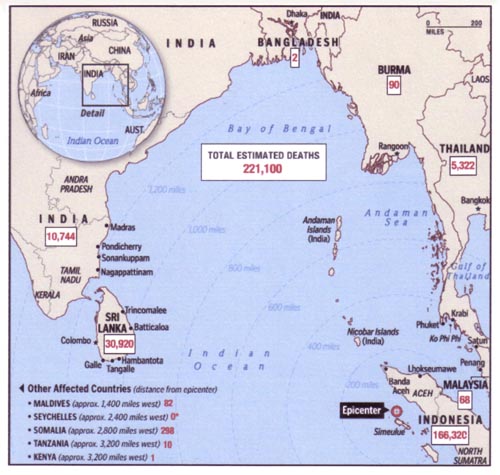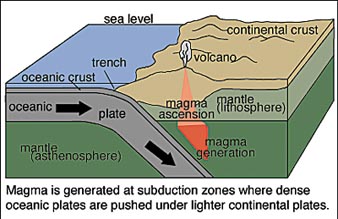
January 2005


Mother cries near
bodies of her children, killed when giant waves hit Nagappattinam,
in southern Indian state of Tamil Nadu. They did not have to die. (Photo: Gautam Singh/AP)
The
media keeps reiterating that there is no history of tsunamis in the
Indian
Ocean and so the deadly waves could not have been predicted. This is
self-serving nonsense. Dr. Tad Murty, vice president of the Tsunami
Society who
is affiliated with the Unviersity of Manitoba in Winnipeg, Manitoba
(Canada),
told the Calgary Sun (28 December 2004) that with 25 minutes to
four
hours warning time, it was possible to save the victims: “Once again,
because
of indifference and corruption thousands of innocent people have died
needlessly.” Moreover, barely three months ago, AusGeo
(September 2004),
an Australian government publication, ran a lead article, noting that
“There is
an international tsunami warning system for the Pacific Ocean, but none
for the
Indian Ocean.” The article pinpointed the danger of a massive
earthquake that
could generate a tsunami in precisely the area where it occurred, the
northwestern sector of the Sunda Trench off Sumatra. They even did
tsunami modeling
based on the 1833 Sumatra earthquake which may have been a 9.2 on the
Richter
scale. The modelling corresponds exactly to what happened three months
later.
The AusGeo article was titled
“Small threat, but WARNING
SOUNDED for tsunami
research.” Why a “small” threat? Because in the numerical simulation by
Geoscience Australia, “most of the tsunami energy radiates out into the
Indian
Ocean and not toward Australia”! This is the same
bureaucratic-chauvinist
outlook that led the American National Oceanic and Atmospheric
Administration
to excuse its initial “no threat” alert with the CYA (cover your ass)
statement
that “there was no threat of a tsunami to Hawaii, the West Coast of
North
America or to other coasts in the Pacific Basin – the U.S. area of
responsibility”
(noaanews, 26 December 2004). No danger to California, no danger to
Western
Australia, only to a region populated by millions of poor people jammed
against
the sea? Only a “small threat,” then, that’s not in their “area of
responsibility.” Could there be a more devastating admission of
national
narrowness and imperialist arrogance, or a more powerful argument for
international socialist planning?
“‘I reaffirm that a tsunami is going to occur for sure,’ said Mr. Smith, a government official who had once been the nation’s chief meteorologist.
“His warning, made first in a speech and picked up by newspapers in the summer of 1998, quickly spread throughout the country, setting off panic – and outrage….
“Government officials, fearful of a washed-up tourist season, branded Mr. Smith a dangerous man with a screw loose. Authorities on the resort island of Phuket fastened loudspeakers to pickup trucks to broadcast a mollifying message to beachgoers – and warned Mr. Smith not to come to town.”
–Wall Street Journal, 10 January
Mr. Smith studied
tsunamis in the Pacific Ocean and noted that every one had begun with
an
earthquake registering at least 7.4 on the Richter scale. The only
place this
was likely to occur near Thailand was the geological fault along the
Sunda
Trench off Sumatra, and he concluded that this would place the beach
resort of
Phuket directly in a tsunami’s path. “If they had just listened,” the
meteorologist lamented. On the morning of December 26, after reports of
the
earthquake but before the waves hit Phuket, Mr. Smith tried to reach
the Thai
meteorological department, but he was unsuccessful.
 Map by Farhana Hossain and Laris
Karklis, The Washington Post; Brian Cordyack, Nelson Hsu and Alyson
Hurt, washingtonpost.com
Map by Farhana Hossain and Laris
Karklis, The Washington Post; Brian Cordyack, Nelson Hsu and Alyson
Hurt, washingtonpost.com
But
in fact, the Thai meteorological department knew of the earthquake and
decided not
to issue a warning, out of concern for the effect on the tourist trade.
An
article by Pravit Rojanaphruk in the Bangkok daily The Nation
(28
December) reports that shortly after the quake, department officials
convened
an emergency meeting. A tsunami had not hit Thailand in 300 years, they
reasoned. But, a source told the newspaper, “The very important factor
in
making the decision was that it’s high [tourist] season and hotel rooms
were
nearly 100-per-cent full. If we issued a warning, which would have led
to
evacuation [and if nothing happened], what would happen then? Business
would be
instantaneously affected. It would be beyond the Meteorological
Department’s
ability to handle. We could go under, if [the tsunami] didn’t come.”
“Precisely
at 9 am that Sunday, waves as high as 3 to 10 metres hit the main
southern
coastal provinces,” The Nation added. More than merely a case
of
criminal negligence, we see here how the logic of capitalist economics
snuffs
out thousands of lives.
The
bottom line is that any truly international scientific effort to stem
the damage
caused by maritime and seismological events would have long ago
established
warning systems in the Indian Ocean. Punishing cyclones and monsoon
storms are
a regular occurrence as are the deaths of thousands of Bangladeshis in
the
periodic flooding of the lowland areas along the Bay of Bengal. The
entire
Pacific Basin is circled by a “ring of fire” which includes more than
four-fifths of the major active volcanoes in the world. These volcanoes
are
located along the edges of continents, island chains or underwater
mountain
ranges where the dozen large plates that make up the earth’s surface
abut.
According to the plate-tectonics theory which has been widely accepted
since
the 1970s, most earthquakes (and many volcanic eruptions) occur at the
outer
edges of these plates. The Sunda trench is at the extreme western edge
of this
“ring of fire,” where the so-called India Plate “subducts” (goes under)
the
Burma Plate. Along the west coast of Sumatra is a long string of three
dozen
volcanoes located to the east of the Sunda Trench.
There
are different kinds of earthquakes, and not all produce tsunamis. Where
the
plates collide laterally (along so-called strike-slip faults), as along
the
West Coast of the United States, except for the Cascadian fault, the effects are mostly localized. The
largest tsunamis generally occur as a result of thrust earthquakes in
subduction zones, where one plate slips under another, thus displacing
upwards
massive quantities of rock and water. In the recent megathrust
earthquake off northern
Sumatra, the upward shift was estimated at 15-20 meters (50-65 feet)
and it
extended over an unusually long arc of 1,200 kilometers (750 miles).
The
initial quake was followed by almost 70 aftershocks and the eruption of
a mud
volcano in the Andaman Islands to the north. The Sumatra earthquake
came just
three days after another major quake (8.1 on the Richter scale) in an
uninhabited area north of Macquarie Island, at the opposite end of the
Indoaustralian plate, which is unusual as such major quakes occur on
the
average of one a year. The Sumatra quake also came exactly one year (to
the
hour) after the deadly earthquake in Bam, Iran, that killed some 30,000
people.
 Sumatra Subduction Zone
Sumatra Subduction Zone
Graphic by University of North
Dakota/Volcano World
Various
conspiracy buffs have circulated elaborate theories about how the
Sumatra quake
could have been part of a diabolical plot set off by mad scientists
using the
U.S. HAARP (High Altitude Active Aural Research Program) technology
being
developed as part of the Reagan-Bush Strategic Defense Initiative (SDI,
or
“Star Wars”) in order to seize Aceh oil/gas as part of the rescue. (Of
course,
the U.S. oil giant Exxon-Mobile already controls the Aceh gas fields.)
Going
even farther afield, they relate this to the four unusually strong
Caribbean
hurricanes last fall and the recent pounding storms on the U.S. West
Coast.
Putting aside such conspiracy mongering, and leaving open whether there
are
some causal relations among recent seismic activity or just
coincidence, the
fact is (as the Thai meteorologist and Geoscience Australia both
warned) that the
area off Sumatra was a logical place for a major earthquake producing a
huge
tsunami to take place. It is a geologically young area with lots of
volcanic activity, which in the past had unleashed killer waves. In
addition to
the 1833 quake/tsunami modeled by the Australian scientists, there was
the
famous Krakatoa volcano eruption of 1883 which was recently chronicled
by Simon
Winchester in his book Krakatoa. The Day the World Exploded, August
27, 1883
(HarperCollins, 2003). This unleashed giant waves up to 40 meters high,
killing
36,000 people in the coastal towns and villages of the Sunda Strait
between
Java and Sumatra.
As
for the measures that could have been and should have been undertaken
long ago,
the placement of wave sensors on ocean buoys in the Indian Ocean would
have
been simple. The cost (at $250,000 each) is minuscule when compared to
the vast
amounts U.S. imperialism spends on high tech military equipment – but,
of
course, such devices designed to protect a vulnerable civilian
population don’t
serve to “shock and awe” the Pentagon’s adversaries. Indeed, given the
amount
of U.S. naval activity in the Indian Ocean, it is quite possible that
underwater sensors are already there (as they are in great
quantity in
the North Atlantic) and able to detect water movements, but their
information
is classified. The means for notifying coastal populations of impending
danger
are more complicated, in the chaotic conditions of semi-colonial
capitalism.
However, the largest numbers of deaths occurred in coastal cities and
towns,
where powerful warning sirens could easily be installed just as tornado
warning
sirens were in the U.S. Great Plains states decades ago. The numbers of
deaths
now occurring because of untreated injuries becoming infected and
festering
could have been avoided had Indonesia had a medical system with
disaster
response teams ready to move.
In
short, 225,000 people didn’t have to die. There were simple measures to
avoid
this calamity that could have been taken and should have been taken
long ago.
Some scientists did foresee the possibility of Indian Ocean
tsunamis,
but their warnings were squelched. Solid housing can be built on safe
ground,
far enough inland that it is not threatened by pounding seas. An Indian
writer
in the New York Times (14 January) noted that, in contrast to
Europe,
“the ancient harbor cities of southern Asia … are often situated
upriver, at a
cautious distance from open water.” But all this implies the existence
of a
society in which the needs of the population are determining, rather
than the
interests of the profit-hungry giant “multinational” corporations and
the
murderous militaries that serve as their guard dogs. It’s not a matter
of
“priorities,” as liberals and reformists would have you believe, but of
class interests.
Although the scientific and medical wherewithal to prevent such
horrendous loss
of life already exists and is easily available, it will take a
revolution to
put it in place. n
To contact the Internationalist Group and the League for the Fourth International, send e-mail to: internationalistgroup@msn.com